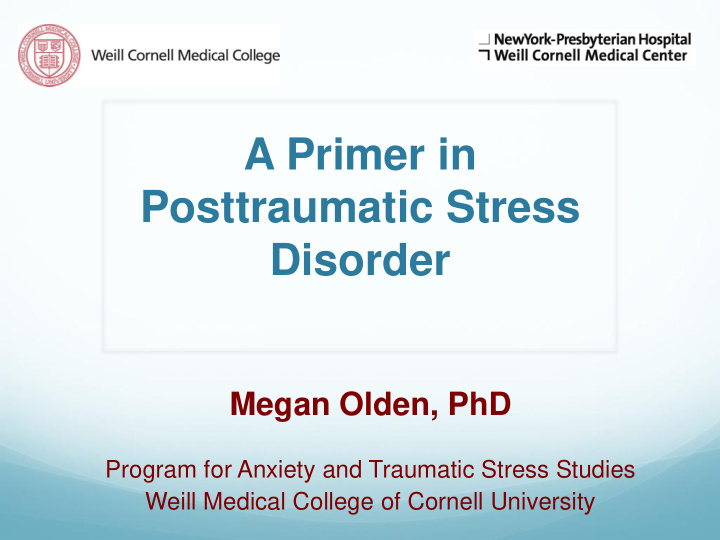



A Primer in Posttraumatic Stress Disorder Megan Olden, PhD Program for Anxiety and Traumatic Stress Studies Weill Medical College of Cornell University
What is PTSD?
DSM-IV PTSD Diagnostic Criteria • Exposure to a traumatic event and subjective emotional response of fear, helplessness or horror • Persistent re-experiencing of the traumatic event (3) • Persistent avoidance and numbing (3) • Persistent symptoms of increased arousal (2) • Duration of more than 1 month • Significant distress or impairment DSM-IV. American Psychiatric Association, Washington D.C., 1994
A Prospective Examination of PTSD in Rape Victims Percent of Victims with PTS 100 94 79 80 70 64 59 55 60 53 53 48 47 45 41 Percent (%) 40 20 0 1 2 3 4 5 6 7 8 9 10 11 12 Assessment Rothbaum BO et al. J Traumatic Stress. 1992;5(3):463
Extinction and Habituation • We view PTSD as a disorder of extinction
Chronicity of PTSD How long will symptoms last? Is chronic PTSD a disorder for life?
How does PTSD present?
“As we walk, he hews close to the buildings on his right (“If a building’s to my right, no one is going to walk by me on my right”), and when we arrive at the restaurant, he quietly takes a seat at the table closest to the door, his back against the wall. His large brown eyes immediately start darting around. “How’s your sleep?” I ask him. “I don’t,” he answers. Booth manages his driving anxieties by leaving his Long Island home every morning at 4:30 a.m., when there’s no risk of traffic (especially under bridges, which militants in Iraq are always blowing up), and avoiding the right lane…Once he gets to the city, Booth parks around the corner from his office and has managed to arrange his life so that he never encounters more than a handful of people. The only real logistical challenge is lunchtime, which he handles by ordering in, picking up from a grill across the street, or skipping entirely.” Description of David Booth, a 39-year- old former medic and surgeon’s assistant who retired this past spring after nineteen years in the active Army Reserve New York Magazine, Feb. 6, 2011, Jennifer Senior
Treatment
Exposure Therapy • Considered the first-line treatment for PTSD (Foa, Davidson, & Frances, 1999; Foa, Rothbaum, & Furr, 2003). • Recent Institute of Medicine (IOM) report concluded that exposure therapy is the ONLY treatment with sufficient empirical evidence to recommend it (IOM, 2008).
Exposure Therapy Principles Extinction training exposure to feared stimulus repeatedly and for prolonged period leads to habituation and extinction based on learning principles reliable findings with animals and phobic disorders Therapeutic Exposure
Prolonged Exposure: Techniques Imaginal Exposure In Vivo Exposure Includes Education Breathing Relaxation Cognitive Therapy Virtual Reality Exposure Foa, Hembree & Rothbaum (2007). Prolonged Exposure Therapy for PTSD: Emotional Processing of Traumatic Experiences, Therapist Guide. New York. Oxford University Press. Rothbaum, Foa & Hembree (2007). Reclaiming Your Life from a Traumatic Experience: Client Workbook. New York. Oxford University Press.
Virtual Reality Exposure Therapy: What is it? An immersive virtual reality system consists of special 3-D software, head tracking sensors, and a helmet mounted visual display Patients wear a helmet with two goggle-sized miniature computer monitor screens Scenery in VR changes as users move their head orientation
Why use VR? Enhances emotional involvement Makes it possible to control intensity May offer perception of increased control Incorporates many of the non-verbal or sensory elements of experience (sight, sound, olfaction, kinesthesis)
Virtual Vietnam Hodges, Rothbaum, Graap, Pair et al. In 1997, researchers at Georgia Tech released the first version of the Virtual Vietnam VR scenario. This occurred over 20 years following the end of the Vietnam War. Ready et al. (1998) – Atlanta VA early pilot study 34% decrease in clinician-rated PTSD symptoms 45% decrease in self-rated PTSD symptoms
Virtual Iraq and Virtual Afghanistan Funded by
Virtual Iraq City Building Interiors
Virtual Iraq Humvee Interior Action View
Case Study: First Veteran in Virtual Iraq (4 sessions) – CAPS Gerardi, Rothbaum, Ressler, Heekin, & Rizzo (2008). Virtual Reality Exposure Therapy Using a Virtual Iraq: Case Report. Journal of Traumatic Stress , 21, 209-213
Myths About PTSD and its Treatment
Myths About PTSD 1) Everyone who experiences a major trauma will develop PTSD 2) PTSD develops in individuals who are weak and cannot handle stress as well as other people 3) People with PTSD are violent and unpredictable 4) Someone with chronic PTSD can never get better
Myths About Exposure 1) Encouraging trauma survivors to relive their trauma in imagination (the key component in exposure) is cruel and revictimizing. 2) Exposure can only be used with survivors of discrete traumas such as rape, natural disaster, and motor vehicle accidents. 3) Exposure can only be used with individuals who are healthy and stable; it cannot be used with the typical trauma survivor who is complex and fragile. Astin, M. & Rothbaum, B.O., (2000). Exposure Therapy for the Treatment of Posttraumatic Stress Disorder. National Center for PTSD Clinical Quarterly, 9, 49- 54.
Thank you for your time! Feel free to contact me with any questions: meo9011@med.cornell.edu Read about our work and research: www.patss.com
Recommend
More recommend